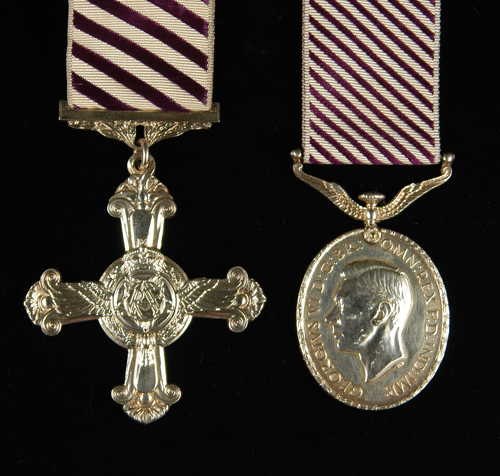
Auction: 7022 - Orders, Decorations, Medals & Militaria
Lot: 1243
An Outstanding Second War 1942 D.F.C., ´Immediate´ 1941 D.F.M. Pair to Hampden and Lancaster Pilot, Flying Officer J.D.V.S. Stephens, Royal Air Force Volunteer Reserve, Who Was Later Killed in Action on a Sortie to Wismar, 1.10.1942 a) Distinguished Flying Cross, G.VI.R., reverse officially dated ´1942´ b) Distinguished Flying Medal, G.VI.R. 742771. Sgt. J.D.V.S. Stephens. R.A.F.), good very fine (2) Estimate £ 3,400-3,800 D.F.C. London Gazette 6.11.1942 Pilot Officer J.D.V.S. Stephens, D.F.M. (103510) R.A.F.V.R. 44Sqn. The Recommendation, dated 23.9.1942, states: ´´This captain has shown the greatest possible determination to seek out and bomb his target on all occasions and has only failed to do so by reason of weather or engine failure. He has completed twenty four sorties in his second tour of operations. An example of the way in which he tackles his job occurred recently when early on the outward journey to Bremen, his port inner engine caught fire. He feathered the propeller, extinguished the fire and continued on his way. However, it was not possible to reach Bremen in time so he attacked an aerodrome near Lingen. D.F.M. London Gazette 4.7.1941 Sergeant J.D.V.S. Stephens No. 83 Sqn. The Recommendation, dated 16.6.1941, states: ´´At Briefing for the attack on Soest marshalling yard (on the night of the 12/13th June 1941) the importance of all the pilots doing their utmost to identify the precise marshalling yard for which they were detailed to attack, was stressed in view of the large number of railway lines and marshalling yards which are located in the Ham, Soest, Unna, Lippstadt area. On arrival in the vicinity of Soest on the night of the 12th/13th June 1941, Sergeant Stephens, Captain of Aircraft, found the target area obscured by low cloud and poor visibility. He, therefore, reduced height to 1000 feet and made a careful reconnaissance of the target by the light of flares dropped from the other aircraft. When the target had been accurately located Sergeant Stephens made three dummy runs over the target at a height of 1500 feet. On the fourth run his bombs were released and seen to burst on the permanent way. He then descended to 800 feet and proceeded to machine gun a train standing in the marshalling yard. Sergeant Stephens has at all times shown great keenness for operations and a strong desire to force home his attacks and the operation carried out on the night of the 12th/13th by this Pilot is a true example of the initiative and daring which he always displays when over enemy territory. His own reports of operations are always reserved and unadorned and it is only by the analysis of the reports given by the other members of his crew that a true estimate of his devotion to duty, initiative and cool courage can be obtained and I strongly recommend him for an immediate award of the Distinguished Flying Medal It is noteworthy that since the beginning of May Sergeant Stephens has carried out eleven operational flights of which only one was a failure and in that instance the failure was due to very adverse weather over the gardening area at Brest. Remarks by Officer Commanding: This was a particularly gallant effort and a splendid example to all crews. The Immediate award is very strongly recommended.´´ Flying Officer James Douglas Vernon Stewart Stephens, D.F.C., D.F.M., flew in his first tour of operations in the Second World War with 83 Squadron (Hampdens), Scampton, Lincolnshire; before transferring as Pilot Officer to 44 (Rhodesian) Squadron (Lancasters), Waddington, Lincolnshire, with whom over the course of 1942 he flew in over 24 operational sorties to heavily defended German targets including: Cologne; Essen (4); Duisberg (2); Hamburg; Saarbrucken; Dusseldorf (2); Munster; Mainz; Kassel; Karlsruhe; Bremen (2); Frankfurt and Wilhelmshaven; until 1.10.1942, whilst piloting Lancaster W4187 KM-S on a sortie to Wismar, ´´T/O 1800 Waddington. Crashed 2119 on the Skallingen, a spit of land NW of Esbjerg, Denmark´´ (Bomber Command Losses of the Second World War, refers), the entire crew of seven were killed in action, and are buried in Fourfelt Cemetery, Esbjerg, Denmark.
Sold for
£3,100




